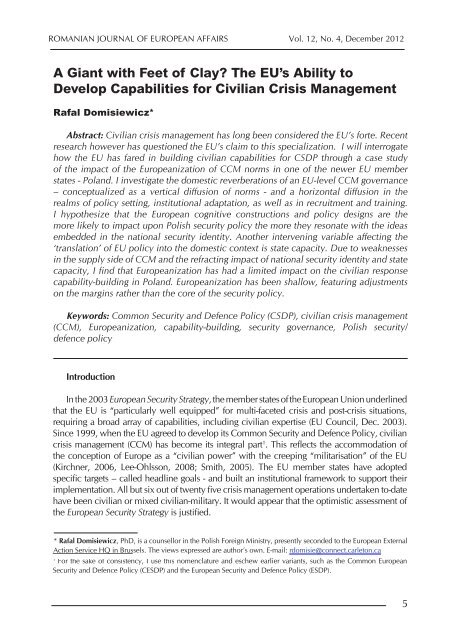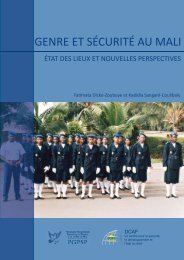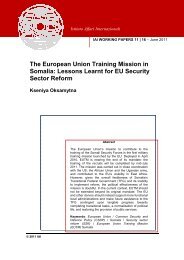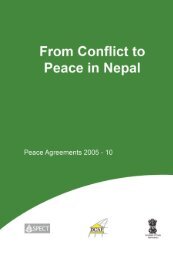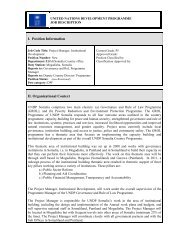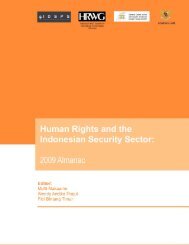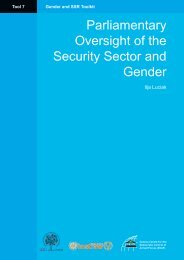The EU's Ability to Develop Capabilities for Civilian Crisis ... - ISSAT
The EU's Ability to Develop Capabilities for Civilian Crisis ... - ISSAT
The EU's Ability to Develop Capabilities for Civilian Crisis ... - ISSAT
You also want an ePaper? Increase the reach of your titles
YUMPU automatically turns print PDFs into web optimized ePapers that Google loves.
Rafal DomisiewiczYet, over a decade since the launch of the CSDP one review after another stresses the limitedprogress attained in building the capacity <strong>for</strong> civilian crisis management. In its 2011 Report onthe development of the common security and defence policy following the entry in<strong>to</strong> <strong>for</strong>ce ofthe Lisbon Treaty, the European Parliament’s Committee on Foreign Affairs “regrets the scantresults achieved by the <strong>Civilian</strong> Headline Goal 2010 process regarding civilian capabilities”(EP, A7-0166/2011). <strong>The</strong> 2012 report by the Friedrich Ebert Stiftung notes “a lack of expertiseon the part of the member states and a failure <strong>to</strong> implement existing strategies” (FES, Apr. 2012).Even the Council officials admit that a “coherence and an overall EU approach is still fairlydifficult <strong>to</strong> achieve across pillar boundaries” (2010:7).In this paper I ask whether such pessimism is warranted by interrogating how the EU hasmanaged building civilian capabilities <strong>for</strong> CSDP. I will do so through a case-study of CCMapplication in one of the newer EU member states – Poland. Should the EU have succeeded instimulating capacity-development in a new member state, this would put the critique in doubt.I shall pursue the analysis at two interlinked levels: the EU level and the member state level. Atthe EU level of analysis I assess whether there is coherence between the concepts, methodologyand an institutionalization of CCM that would facilitate national policy adaptation. <strong>The</strong> ability<strong>to</strong> carry out new policy hinges on policy coherence, defined as “the ability <strong>to</strong> articulate policygoals and align resources <strong>to</strong> obtain them” (Rynning, 2011). At the national level, I investigatethe domestic reverberations of an EU-level CCM governance (a vertical diffusion of norms),and a horizontal diffusion in the realms of policy setting, institutional adaptation, as well as inrecruitment and training.<strong>The</strong> timeframe encompasses the period of the development of CSDP and concludeswith Poland’s EU Presidency in the second half of 2011. Poland’s compliance with the EUguidelines in the <strong>for</strong>m of such policy outputs as the creation of a legal framework as well asmeans <strong>for</strong> training and recruitment would attest <strong>to</strong> an internalization of the norms of civiliancrisis management. <strong>The</strong> choice of Poland as a case study fills a lacuna in the academic studiesconcerning the adaptation of Polish security and defence <strong>to</strong> the EU (an exception is Chappell,2010). This study does not address Poland’s participation in civilian crisis management, butfocuses instead on the modalities of capability development. <strong>The</strong> methodology follows an indepthliterature analysis, participant-observation, process tracing as well as interviews.<strong>The</strong> research approach<strong>The</strong> promotion of the norms of CCM, envisaging an embedding of civil-military coordinationin all the spheres of security policy, is a process unique <strong>to</strong> the EU. Other institutions, includingthe UN, OSCE and – lately <strong>to</strong> some degree also NATO – have undertaken ef<strong>for</strong>ts <strong>to</strong> buildcivilian capacity and have organized civilian operations, but only the EU has made a concertedef<strong>for</strong>t. Scholars emphasize that civilian crisis management is a novel concept “specific <strong>to</strong> theEU” having “no equivalent parallels in the lexicons of UN, OSCE or non-European regionalorganisations” (Kaldor et al., 2007). I there<strong>for</strong>e analyze the process of the EU member states’internalization of these norms, conceptualized as Europeanization.By contextualizing the CSDP within the “security governance” framework I approach theimpact of “Europe,” in a broader sense than applied in the majority of Europeanization scholarworks. I conceptualize governance processually as “creating the conditions <strong>for</strong> ordered ruleand collective action” in the sphere of security and defence policy (Webber et al. 2004). Thus,6
A Giant with Feet of Clay? <strong>The</strong> EU’s <strong>Ability</strong> <strong>to</strong> <strong>Develop</strong> <strong>Capabilities</strong> <strong>for</strong> <strong>Civilian</strong> <strong>Crisis</strong> Managementintegrating governance in<strong>to</strong> my definition of Europeanization I consider it <strong>to</strong> be a process atthe domestic level in which member states’ policies, institutions and ideas are affected by newpractices, norms, rules and procedures generated at the above-state level of the EU securitygovernance (Irondelle 2003). This definition allows us <strong>to</strong> capture policy triggers that do no<strong>to</strong>riginate only in Brussels, but also in other EU member states or other European structures.I argue that the impact of Europeanization is mediated by two intervening variables: securityidentity and state capacity. Following Rieker I situate the security identity within a dominantsecurity discourse, that is “the general understanding of security shared by the majority of thepolitical elites at a given point in time” (2006). <strong>The</strong> security identity is a cognitive frameworkinstantiating a national strategic culture, which I take <strong>to</strong> be “the socially transmitted, identityderivednorms, ideas and patterns of behaviour that are shared among a broad majority ofac<strong>to</strong>rs and social groups within a given security community, which help <strong>to</strong> shape a rankedset of options <strong>for</strong> a community’s pursuit of security and defence goals” (Meyer 2005, 528). Ihypothesize that the European cognitive constructions and policy designs are the more likely<strong>to</strong> impact upon Polish security policy the more they resonate with the ideas embedded in thenational security identity (Risse 2001).<strong>The</strong> his<strong>to</strong>rical memory, the acquis his<strong>to</strong>rique, has played a strong part in framing thesecurity identity of Poland, like Germany featuring an acute wartime trauma (Banchoff 1999,Berger 1997; Copsey and Haugh<strong>to</strong>n 2009). <strong>The</strong> lessons of the past have translated in<strong>to</strong> a set ofpolicy axioms of the Third Republic (Longhurst and Zaborowski 2007). First, the central aim of<strong>for</strong>eign policy has been the maximisation of security. Mindful of Poland’s existential dilemmas,Polish elites respect the military, support the use of <strong>for</strong>ce and value “hard” security above “softsecurity.” Second, Poland is determined <strong>to</strong> never again become an object of European politics.<strong>The</strong> country aspires <strong>to</strong> play the co-decision-making role it considers its due in the EuropeanUnion and NATO. Third, in a modern vestige of mission civilisatrice, Poland, which in the15th - 18th century in union with Lithuania had extensive landholdings in Eastern Europe,claims a vocation <strong>for</strong> drawing Eastern Europe <strong>to</strong> the Euro-Atlantic community. Fourth, the Poleshave taken <strong>to</strong> heart the principle of solidarity, which translates inter alia in<strong>to</strong> a commitment <strong>to</strong>preventing the de-coupling of the Western security community. European defence is acceptableprovided that a harmonious relationship with NATO and the United States is ensured.Security identity does not determine neatly state preferences. If a “misfit” occurs betweenEuropean and domestic ideas the elites may attempt <strong>to</strong> construct cognitive or institutionalcompatibilities between the new and the old (Marcussen et al. 1999). <strong>The</strong>ir ability <strong>to</strong> do so is<strong>to</strong> a large degree determined by state capacity. It encapsulates both the narrow conception ofadministrative capacity as well as a broader notion of governance, including the possession ofexpertise allowing <strong>for</strong> the “translation” of CSDP in<strong>to</strong> the domestic context, a qualified staff, aneffective interdepartmental coordination (a whole-of-government approach), a culture of longtermplanning, a sound institutional infrastructure as well as resources.<strong>The</strong> EU conceptual-policy frameworkIn line with the post-Cold War security environment, a comprehensive approach hasbecome the norm across international organizations and their members. <strong>The</strong> European SecurityStrategy advocates the application of the “full spectrum of instruments <strong>for</strong> crisis managementand conflict prevention at our disposal, including political, diplomatic, military and civilian,7
Rafal Domisiewicztrade and development activities” (European Council, 2003). <strong>The</strong> EU thus set out <strong>to</strong> integratecivilian and military dimensions of CSDP in the planning, capability-development and theconduct of crisis management operations.Since none of the EU member states, not even the Nordic countries, that influenced mostthe civilianization of CSDP, had the type of integrated, multifunctional civilian rapid reactioncapacities that the EU was calling <strong>for</strong>, concepts, doctrines and standards had <strong>to</strong> be developedfrom scratch (Jakobsen, 2006). Because the comprehensive approach is nowhere defined inthe EU (Wendling, 2010) it may mean different things <strong>to</strong> different ac<strong>to</strong>rs (Drent, 2011; Nowak,2006). This pertains <strong>to</strong> the concepts of civil-military cooperation (CIMIC) and the civil-militarycoordination (CMCO). First brought in<strong>to</strong> NATO, CIMIC entails the use of civilian resourcesin order <strong>to</strong> secure local support and thus contribute <strong>to</strong> the success of the mission (Gebhard,2008). Limited <strong>to</strong> the theatre of operations CIMIC is a subset of a broader concept of civilmilitarycoordination (CMCO), hailed as the EU trademark. It refers <strong>to</strong> “the need <strong>for</strong> effectiveco-ordination of the actions of all relevant EU ac<strong>to</strong>rs involved in the planning and subsequentimplementation of EU’s response <strong>to</strong> the crisis” (Ibid.). CMCO is a strategic-level approach thataddresses the civilian-military interfacing within the EU and – hopefully – the member state’sinstitutional set-ups (Ibid.). Through an Action Plan <strong>for</strong> further strengthening of CMCO in EUcrisis management, the EU has sought <strong>to</strong> integrate civilian ac<strong>to</strong>rs across pillars in<strong>to</strong> planningand implementation of crisis management at political-strategic level (Jankowska, 2007).<strong>The</strong> attainment of CMCO has been impaired by the heterogeneity of cultures of civilianmilitaryinteraction among EU member states as well as problems in setting up the EU’s ownjoint civil-military structures in Brussels. <strong>The</strong> EU Institute <strong>for</strong> Security Studies (EUISS) points outthat the “fact that CCM potentially comprises multiple stages and multiple ac<strong>to</strong>rs and that thereis no agreement on its definition has resulted in some confusion over the definition of CCMat the EU level.” By 2009, no common definition of what encompasses “civilian” had beendeveloped (Gya, 2009).<strong>Civilian</strong> Headline Goal methodology<strong>The</strong> <strong>Civilian</strong> Headline Goals are modelled upon the Open Method of Coordination used <strong>to</strong>develop military capabilities. It encapsulates an establishment of precise, quantitative targets inspecific priority areas (police, rule of law, civilian administration, civil protection, moni<strong>to</strong>ring,support <strong>to</strong> security sec<strong>to</strong>r re<strong>for</strong>m), <strong>to</strong> be met voluntarily initially by 2003 and then by 2008and 2010 (<strong>Civilian</strong> Headline Goals). <strong>The</strong> process entails holding commitment conferences,identifying shortfalls on the basis of the commitment-target gap, and <strong>for</strong>mulating action plans<strong>to</strong> address deficits (Dwan, 2006).Although a new <strong>Civilian</strong> Capability Management Tool powered by a software calledGoalkeeper was launched, lists of non-human resources, such as equipment, compiled, andsince 2008 National Action Plans brought in <strong>to</strong> help the EU members meet CHG commitments,a significant gap remains between commitments on paper and concrete contributions <strong>to</strong> theCCM activities (Angelet and Vrailas, 2008; Korski and Gowan, 2009; Grevi and Keohane,2009). Out of 11,000 civilian experts available, only 3,000 have been deployed in theatre(ISIS, 2010). In 2009, the shortfall were at least 1,500 personnel across 12 CSDP missions thenrunning (Korski and Gowan, 2009:44).8
A Giant with Feet of Clay? <strong>The</strong> EU’s <strong>Ability</strong> <strong>to</strong> <strong>Develop</strong> <strong>Capabilities</strong> <strong>for</strong> <strong>Civilian</strong> <strong>Crisis</strong> ManagementIn the absence of communautarisation, in a policy field open <strong>to</strong> contestation by statesupholding different security identities, the Open Method of Coordination (OMC) may deliveronly modest results, if at all. Lacking coercive mechanisms, voluntary mimetic and normativeprocesses may not be effective enough <strong>to</strong> bring about policy change and action plans turnout <strong>to</strong> be merely summary reports <strong>for</strong> Brussels’ consumption (Borrás and Jacobsson, 2004:195; Korski and Gowan, 2009; Dwan, 2006). Resources committed on paper neither reflectthe reality of what civilian capabilities the EU can actually bring <strong>to</strong> bear in a mission nor helpidentify specific civilian expertise (Dwan, 2006: 9-10). Korski and Gowan quote one diplomatsaying that the CHG remains a “number exercise,” and another, from a new EU member state,describing it as nothing but a “declaration” (2009:44).<strong>The</strong> civilian personnel, such as judges and lawyers, correctional officers or civilianadministra<strong>to</strong>rs, are rooted in the domestic contexts of training and employment. In contrast <strong>to</strong>the military who are pre-trained, pre-equipped and pre-<strong>for</strong>med <strong>for</strong> service abroad rather thanat home, the civilians are called primarily <strong>for</strong> home duty (Dwan, 2006; Jakobsen, 2006; Khol,2010). <strong>The</strong>y must be provided with sufficient incentives <strong>to</strong> leave their domestic duties and goon a <strong>for</strong>eign mission (Gourlay, 2004). Regulations are necessary <strong>to</strong> ensure that civilians retaintheir jobs at home while on deployment, remain eligible <strong>for</strong> promotion and/or pay raise, andare not penalized in terms of vacation and leave. This set of issues has not been taken in<strong>to</strong>account in the majority of the EU member state legislation on the civil service or such sec<strong>to</strong>ralservices as the correctional service or the prosecu<strong>to</strong>r’s office – save <strong>for</strong> the police.Poland, like many other EU member states, has not shied away from making impressivecommitments unmatched by the level of domestic capacity-building. As soon as it enteredthe EU in 2004, Poland pledged 345 experts <strong>to</strong>wards the CHG 2008. It was the sixth largestcontribution after Italy, Germany, France, Spain and the United Kingdom. At the time Polandalso spearheaded discussion within the EU on how <strong>to</strong> unify the regulations and principlesunderlying the training and deployment of civilians in crisis management operations (Kupiecki,2005). In 2004, it even organized a seminar in Warsaw <strong>to</strong> this end. Poland’s generouscommitment and its initial spur of activity had been motivated by a desire <strong>to</strong> make “the firstimpression”. <strong>The</strong> creation of coordination mechanisms <strong>for</strong> participation and training of Polishrepresentatives in the EU’s CCM had actually been mandated during the accession negotiationson the CFSP chapter and recognized as one of the priority tasks in the 2001 National Programmeof Preparation <strong>for</strong> Membership in the European Union, approved by the Polish Council ofMinisters (Council of Ministers, 2001). Because CSDP is an intergovernmental domain theEU could not, however, en<strong>for</strong>ce compliance, so this promise of establishing coordinationmechanisms (save <strong>for</strong> tasking an expert at the CSDP section of the <strong>for</strong>eign ministry’s securitypolicy department with overseeing the process) has by and large remained but a declaration.Institutionalization<strong>The</strong> EU has not set up a coherent civil-military coordination framework able <strong>to</strong> facilitatethe diffusion of norms related <strong>to</strong> civilian crisis management, and foster policy convergence.<strong>The</strong> institutionalization of CCM has been an on-going process of trial-by-error, inhibited bya scattering of organizations across the intergovernmental and community pillars as well asclashing administrative cultures (Gourlay, 2006).9
Rafal DomisiewiczWithin the second pillar alone several institutions have been involved in planning,coordination, supervision and evaluation of CCM. As envisaged at the 2000 Helsinki Council,the Committee <strong>for</strong> the <strong>Civilian</strong> Aspects of <strong>Crisis</strong> Management (CIVCOM) has been established<strong>to</strong> advise the Political and Security Committee (PSC) on running and planning civilianmissions, steering the development of civilian capabilities and helping disseminate commonstandards and best practices (EU Council, 10898/08). It is staffed by Brussels-based nationalrepresentatives, in most cases non-specialist junior diplomats or lower-level officials frominterior or justice ministries. Poland has been represented at CIVCOM by an interior ministryexpert seconded <strong>to</strong> its permanent representation <strong>to</strong> the EU.Due <strong>to</strong> the heterogeneity of membership, limited in<strong>for</strong>mal contacts and other means ofsocialisation, CIVCOM representatives tend <strong>to</strong> be more attuned <strong>to</strong> the national positions(Serrano, 2011). While CIVCOM mainly assists the PSC, an important role in preparing andimplementing decisions related <strong>to</strong> civilian missions was assumed by the Council direc<strong>to</strong>rate IX(<strong>Civilian</strong> <strong>Crisis</strong> Management) of Direc<strong>to</strong>rate General E (External and Political-Military Affairs).At a minilateral summit of France, Germany, Belgium and Luxembourg in April 2003,France proposed setting up a command and control HQ independent of NATO. Because ofBritish objections, as a compromise, a Civil-Military Cell (CivMil Cell) was created within theEU Military Staff (EUMS) <strong>to</strong> bridge both the gap between civilian and military cultures as wellas intra- and inter-pillar organizations and instruments (Gebhard, 2009; Korski and Gowan,2009). <strong>The</strong> Cell was supposed <strong>to</strong> have the capacity <strong>to</strong> set up an Operations Centre (OpCen)<strong>for</strong> an EU mission (Quille et al., 2006). When conducting operations, rather than activating theOpCen the EU goes through pre-selected national HQs multi-nationalised upon call.In August 2007 the EU member states decided <strong>to</strong> create within the Council Secretariatthe <strong>Civilian</strong> Planning and Conduct Capability (CPCC), a nucleus civilian operational HQ,headed by a <strong>Civilian</strong> Operations Commander (CivOpsCdr), who since Lisbon Treaty camein<strong>to</strong> <strong>for</strong>ce reports <strong>to</strong> the High Representative of the Union <strong>for</strong> Foreign Affairs and SecurityPolicy. In December 2008, the European Council agreed <strong>to</strong> yet another innovation – thecreation, alongside the CPCC, of the <strong>Crisis</strong> Management and Planning Department (CMPD).Integrated in<strong>to</strong> the European External Action Service, the CMPD has merged skeletal DG Edirec<strong>to</strong>rates IX and VIII (defence aspects), thus integrating civilian and military planning (Ibid.).Because the <strong>Crisis</strong> Management and Planning Department is brand new, it is difficult <strong>to</strong> assessits per<strong>for</strong>mance. Nor, <strong>for</strong> that matter, is it easy <strong>to</strong> appraise now effectively the European ExternalAction Service (EEAS) has integrated all the <strong>to</strong>ols <strong>for</strong> capability development. Three months in<strong>to</strong>his appointment, in 2011, the CMPD’s head assessed the EEAS as being “not really up <strong>to</strong> speedyet” (Schaaf, 2011). <strong>The</strong> European Parliament advocates a single Direc<strong>to</strong>rate General <strong>for</strong> peacebuilding and crisis management within the EEAS that would marry the Council structures andthe Commission financial instruments in line with the High Representative’s Lisbon mandate<strong>to</strong> “ensure coordination of the civilian and military aspects” of “crisis management, includingpeace-making and post-conflict stabilisation” (TEU, art. 43(2)). Due <strong>to</strong> the sensitivities of themember states, the power tussle between the President of the Commission and the HighRepresentative and the preferences of the HR/VP, such an amalgamation has not happened.Just as the EU has found it difficult <strong>to</strong> tie <strong>to</strong>gether all the ac<strong>to</strong>rs needed <strong>for</strong> a multi-facetedcivilian crisis management, so have a majority of the EU member states. In contrast <strong>to</strong> militarycrisis management, the EU member states have had <strong>to</strong> develop concepts and doctrines adnovum (W<strong>to</strong>rek, 2008; Jakobsen, 2006). While military missions call upon chiefly defence10
A Giant with Feet of Clay? <strong>The</strong> EU’s <strong>Ability</strong> <strong>to</strong> <strong>Develop</strong> <strong>Capabilities</strong> <strong>for</strong> <strong>Civilian</strong> <strong>Crisis</strong> Managementministries/general staffs <strong>to</strong> handle planning, execution and funding, civilian missions requiretight-knit interministerial cooperation as well as a single, effective coordination (W<strong>to</strong>rek, 2008).Sweden, Germany and Finland have devised national strategies <strong>for</strong> civilian crisismanagement rooted in a whole-of-government approach. In 2000, the German governmentproduced a Comprehensive Concept on <strong>Civilian</strong> <strong>Crisis</strong> Prevention, Conflict Resolution andPost-Conflict Peace-Building, followed by an Action Plan (German Federal Government,2004). In 2008, Finland adopted the National Strategy <strong>for</strong> <strong>Civilian</strong> <strong>Crisis</strong> Management, whichtasks the <strong>for</strong>eign ministry with responsibility <strong>for</strong> political coordination and decision-makingwith regard <strong>to</strong> participation in missions, and the interior ministry with capacity-building, whichit exercises through the new <strong>Crisis</strong> Management Centre (Finnish Ministry of Interior, 2008:4;Behrendt and Nutt, 2008). <strong>The</strong> Council and the European Parliament have recommended tha<strong>to</strong>ther EU members adopt similar strategies (EP, 2009/2198).Lacking the resources <strong>to</strong> match its West European counterparts, and in the early 2000slacking in strong central executive coordination, the Polish state has found mobilizing thewhole-of-government approach more difficult. <strong>The</strong> need <strong>for</strong> a comprehensive approach hasonly recently been articulated in Polish strategic documents. In the national strategies of 2000,2003 and 2007 Poland’s support <strong>for</strong> the EU’s military and civilian capacities is mentionedalbeit briefly. <strong>The</strong> ministry of defence in the 2008 Vision of the Armed Forces of the Republicof Poland – 2030 and the 2009 Defence Strategy of the Republic of Poland inserted paragraphlengthstatements addressing the comprehensive approach. <strong>The</strong> first document envisagesthat <strong>to</strong> attain desired political, social and economic objectives, the future military operationswould have <strong>to</strong> be integrated and synchronized with the activities of other government andnongovernmental organizations. <strong>The</strong> future planning process has <strong>to</strong> address military and civiliansynergies (MoD, 2008; Smith-Windsor, 2008). <strong>The</strong> defence strategy states that “planning andconduct of international operations, including the preparation of an adequate civil-militarycomponent is the responsibility of the entire state [emphasis added – RD] and requires thecooperation of many entities” (MoD, 2009). Although these documents appear path-breakingin terms of their cross-sec<strong>to</strong>ral approach <strong>to</strong> crisis management, a closer analysis suggests anarrower, CIMIC-type attitude <strong>to</strong> crisis management rather than the EU’s CMCO.<strong>The</strong> 2009 Strategy of the Republic of Poland’s Armed Forces’ participation in internationaloperations, drafted by the defence ministry in cooperation with the <strong>for</strong>eign ministry, is the firstdocument <strong>to</strong> express a state commitment <strong>to</strong> raising civilian capabilities. Although it comes in asingle paragraph in the 6-page document, its wording is rather strong:“<strong>The</strong> engagement of Poland in international operations is a national ef<strong>for</strong>t. Hence, thereis a need <strong>to</strong> develop, in addition <strong>to</strong> already functioning procedures <strong>for</strong> the preparationand deployment of the armed <strong>for</strong>ces of the Republic of Poland abroad, also proceduresregulating the participation of state administration institutions other than the ministry ofnational defence in international operations. <strong>The</strong>re<strong>for</strong>e, appropriate legal, organizationaland financial arrangements will be adopted in order <strong>to</strong> ensure a broad participationof civilian specialists (inter alia from the ministry of <strong>for</strong>eign affairs, ministry of internalaffairs and administration, nongovernmental organizations) in international operations.This concerns both the phase of state preparation <strong>for</strong> participating in an operation, theperiod of an engagement within an area of its responsibility in a given mission, as wellas the phases of rebuilding and post-conflict reconstruction” (MoD, 2009).11
Rafal Domisiewicz<strong>The</strong> Ministry of Internal Affairs and Administration (MIAA) officials admit that the lack oflegal-institutional arrangements reflected the “weakness of administration”. <strong>The</strong>y also opinethat this newfound interest in addressing the civilian deficit owes <strong>to</strong> the choice of CSDP asone of the priorities of Poland’s 2011 EU presidency (MIAA Interview, 2009; Goetz, 2001;Zubek, 2006). Poland’s ISAF experience, particularly the difficulty it has had in leading its ownPRT, also prompted the MoD <strong>to</strong> tackle this issue. Perhaps this experience rather than the EUinfluence per se has been a greater stimulus.Polish experts agree that the foundation of a systemic framework <strong>for</strong> civilian capacitybuildingrequires a major legislative and administrative overhaul (Polish Institute ofInternational Affairs interview, 2009; European Centre Na<strong>to</strong>lin interview, 2009). Failure <strong>to</strong>adapt would leave Poland as a relatively weak player, not only in CCM, but in CSDP generally(Polish EU mission interview, 2009). After the 1999 Helsinki summit, the EU department inthe ministry of interior drafted an internal concept paper on ways and means of developingPolish civilian capabilities. It failed <strong>to</strong> solicit a willing response by the decision-makers (MIAAinterview, 2009). <strong>The</strong> ministry officials <strong>to</strong>ok com<strong>for</strong>t in the fact that the 1990 Police Act alreadyprovided <strong>for</strong> the secondment of police officers <strong>for</strong> deployment as part of police contingentsin peacekeeping missions (Journal of Laws, 2007). <strong>The</strong> administration has there<strong>for</strong>e s<strong>to</strong>vepipedCCM commitments, limiting it <strong>to</strong> police. It is easier <strong>for</strong> decision-makers <strong>to</strong> tick off thedeployment of military police as a contribution <strong>to</strong> civilian missions rather than <strong>to</strong> undertakethe complex work of adapting the state institutions <strong>to</strong> the demands of CCM (European CentreNa<strong>to</strong>lin interview, 2009).A strong impulse <strong>to</strong> examining legal and procedural questions related <strong>to</strong> deploymen<strong>to</strong>f civilians in operations came with Poland’s socialization in NATO, and in particular itsexposure <strong>to</strong> the CIMIC concept during the US-led mission in Iraq. <strong>The</strong> Polish Land ForcesCommand had already in 2001 taken on the task of translating and inscribing CIMIC in<strong>to</strong>Polish law, but with little results. Three years later, this job was handed over <strong>to</strong> the Office ofthe Civil Service, overseeing the whole bureaucracy. <strong>The</strong> Office debated whether <strong>to</strong> draft anew law, such as the Finnish Act on the Participation of <strong>Civilian</strong> Personnel, or address thisproblem through legislative patches (Majcherkiewicz, 2009). <strong>The</strong> work on drafting a law orotherwise administrative procedures on the deployment of civilians ended up in the securitypolicy department of the <strong>for</strong>eign ministry. <strong>The</strong> department had already in 2003 started <strong>to</strong>conceptualize a law on a secondment of civilian officials, which has yet <strong>to</strong> become reality. Itassumed a role of a coordina<strong>to</strong>r of CCM among the Polish institutions. While the Finnish MFAhas an entire administrative unit dedicated <strong>to</strong> civilian crisis management, one person within thesecurity department’s CSDP section of 4 is responsible <strong>for</strong> it.Change is coming, albeit slowly. <strong>The</strong> Regulation of the Council of Ministers of 19 June2006 on the service of officers of the Border Guard in the Border Guard contingent addressesthe issue of <strong>for</strong>eign deployments <strong>for</strong> border guard officers. <strong>The</strong> new Act of 27 August 2009on the Cus<strong>to</strong>ms Service also contains procedures related <strong>to</strong> the secondment of personnel <strong>to</strong>the EU (Journal of Laws, 2009a). <strong>The</strong> draft 2009 law on the correctional service elaborates atgreater length regulations on the secondment of correctional service officers <strong>to</strong> internationalorganizations. However, policy adaptation takes place within sec<strong>to</strong>rs rather than across-theboardthroughout the administration.12
A Giant with Feet of Clay? <strong>The</strong> EU’s <strong>Ability</strong> <strong>to</strong> <strong>Develop</strong> <strong>Capabilities</strong> <strong>for</strong> <strong>Civilian</strong> <strong>Crisis</strong> ManagementRecruitment<strong>The</strong> EU neither promotes generic recruitment nor maintains an in-house roster ofdeployable experts. Relevant norms have been diffused by means of the EU Council’s 2006Draft recommendations and guidelines on the raising of personnel <strong>for</strong> EU civilian crisismanagement and a horizontal sharing of in<strong>for</strong>mation on the recruitment, exchanges of knowhow,best practices and lessons learned (EU Council, 16696/06). <strong>The</strong> <strong>Civilian</strong> Planning andConduct Capability recruits national experts through Calls <strong>for</strong> Contributions <strong>to</strong> the memberstates (Behrendt and Nutt, 2009), and it is up <strong>to</strong> the member states <strong>to</strong> supply the candidates.Nineteen EU member states have either integrated rosters, which include the police officersand other civilian personnel, or police databases; 3 are in the process of developing rosters;and 5 have none (Korski and Gowan, 2009). Finland, through its <strong>Crisis</strong> Management Centre,Germany, a quasi-governmental Centre <strong>for</strong> International Peace Operations (ZIF) and theUnited Kingdom, through the Stabilization Unit, have pioneered civilian rosters of individualshailing from both the government and the non-government sec<strong>to</strong>r (Behrendt and Nutt, 2009;Korski and Gowan, 2009; Gourlay, 2006). <strong>The</strong> British model has inspired the Netherlands andDenmark <strong>to</strong> set up similar outfits (Behrendt and Nutt, 2009; Gourlay, 2006). Belgium has alsoestablished a database of civilian personnel <strong>for</strong> CSDP operations (Korski and Gowan, 2009).In Poland ad hoc-ism prevails. Only the police is said <strong>to</strong> maintain an embryonic database ofpolice staff <strong>for</strong> EU, UN and OSCE missions, which it is said <strong>to</strong> be considering expanding in<strong>to</strong>a fully-fledged roster <strong>to</strong> include also experienced police officers, retired staff and veterans ofpolice deployments. However, police bosses are wary of standardizing recruitment proceduresand centralizing rosters as this would take away their discretionary power <strong>to</strong> dangle the carro<strong>to</strong>f financially lucrative <strong>for</strong>eign deployments <strong>to</strong> their subordinates. Austria, Cyprus, Portugal andSlovakia have only police rosters (Ibid.).<strong>The</strong> Polish police have developed some planning and recruitment mechanisms <strong>for</strong>deploying police contingents. This is a responsibility of a division in charge of policecontingents and liaison officers within the international police cooperation bureau at theNational Police Headquarters (NP HQ). <strong>The</strong> bureau screens and interviews the candidates aswell as coordinates pre-deployment training.As part of the 2009 switch from a conscript army <strong>to</strong> an all-volunteer <strong>for</strong>ce a 20,000 strongNational Reserve Forces within the 120,000-strong Polish military was <strong>to</strong> be created. This wouldprovide the defence ministry a pool of deployable civilian specialists. It already supervises theso-called Military Police Specialized Units, founded in 2004-2005 as rapidly deployable unitsof the Military Gendarmerie <strong>for</strong> duty abroad. In 2006 the Polish Military Gendarmerie accededas a partner <strong>to</strong> the then five-nation European Gendarmerie Force (France, Italy, Netherlands,Portugal and Spain, and since 2008 Romania), of which the EU may avail. Warsaw expectsthat the European Gendarmerie Force (EGF) would in the near future evolve from a multilateralinitiative and become a common EU project (Polish Council of Ministers, 2005:72).<strong>The</strong> EU has urged “Member states <strong>to</strong> consider, in accordance with their national legislation,expertise from the NGO and CSO [civil society organizations] sec<strong>to</strong>r, when establishing ordeveloping rosters <strong>for</strong> deployment in civilian crisis management missions” (EU Council,15741/06). Poland has taken little heed. Polish nongovernmental experts criticize the inabilityof the <strong>for</strong>eign ministry <strong>to</strong> utilize the strength of the Polish NGOs active abroad (EuropeanCentre Na<strong>to</strong>lin interview, 2009). <strong>The</strong> unwillingness <strong>to</strong> solicit expertise from outside reflects astill conservative bureaucratic culture in Poland.13
Rafal DomisiewiczTrainingAt the 2000 Feira European Council the EU member states committed <strong>to</strong> “consider ways<strong>to</strong> train” judges, prosecu<strong>to</strong>rs and penal experts within the rule of law capabilities, and likewise“consider improving the… training” of civil administration experts and police officers <strong>for</strong>civilian crisis management (European Council, 2000). Although one detects an incrementaltrend <strong>to</strong>wards strengthening EU-level ef<strong>for</strong>ts, European civilian training policy “remains in itsinfancy” as member states guard their prerogatives (Jakobsen, 2006). However, the record ofmember states’ provision of training remains at best mixed and at worst severely deficient.In 2003-2004, the member states endorsed the EU Training Policy in CSDP and the EUTraining Concept in ESDP (Council 14176/2/03). This policy has been underlain by a socializingmotif - <strong>to</strong> “develop throughout the Union a common CSDP culture,” as well as enhance theefficiency of CCM and interoperability at the operational level (Ibid.). In 2001, the Commissionstarted a pilot project on Training <strong>for</strong> <strong>Civilian</strong> Aspects of <strong>Crisis</strong> Management. This program,known as the European Group on Training <strong>for</strong> <strong>Civilian</strong> Aspects of <strong>Crisis</strong> Management (EGT)links 13 training institutes and NGO training providers from as many member states (Jakobsen,2006; Lieb, 2010). Even though, in 2002-2009, the EGT offered 68 courses <strong>for</strong> a <strong>to</strong>tal of 1,399civilian experts, few of them have ever been deployed. <strong>The</strong> design of the program may bear alarge share of the blame (Gauthier, 2011; Gourlay, 2004). Notwithstanding the Lisbon Treaty’selimination of the pillar structure of the EU, CSDP remains intergovernmental, while traininghas stayed under the funding and contracting authority of the Commission, with the memberstates unable <strong>to</strong> provide meaningful input (Gauthier, 2011). Renamed since 2010 Europe’sNew Training Initiative <strong>for</strong> <strong>Civilian</strong> <strong>Crisis</strong> Management (ENTRi), coordinated now by BerlinbasedZIF, it has shifted focus <strong>to</strong> harmonizing and standardizing course curricula (Gauthier,2011).<strong>The</strong> EU Training Concept <strong>for</strong> CSDP launched the European Security and Defence College(ESDC). It has a mandate <strong>to</strong> conduct strategic-level CSDP training, <strong>to</strong> develop and promote acommon understanding of the policy among civilian and military personnel, and <strong>to</strong> identifyand disseminate best practices (EU Council, 2005/575/CFSP, 2008/550/CFSP). Although theESDC has ran a number of courses relevant <strong>to</strong> CCM, a lion’s share of its offer addresses themilitary dimension of CSDP (Lieb, 2010). Based on a networked-architecture, with no centralbudget, and only a small secretariat, the College is incapable of facilitating a strong cooperation(Gauthier, 2011). <strong>The</strong> relations between the EGT/ENTRi and ESDC have been strained bycompetition, overlaps in courses and functions, as well as fear on the part of the <strong>for</strong>mer thattraining <strong>for</strong> civilian crisis management could be “taken over” by the “military ESDC” (Lieb,2010).Two other innovations, also network-based, have not provided strong EU solutions <strong>to</strong>CCM training. In 2000, the EU Council provided <strong>for</strong> setting up the European Police College(CEPOL) tasked inter alia with developing and training police <strong>for</strong>ces of the member states<strong>for</strong> CCM (Council, 2005/681/JHA). <strong>The</strong> Commission <strong>to</strong>o entered the fray since 2007 fundingthe European Police Force Training (EUPFT), which until 2011 has provided operational-leveltraining <strong>for</strong> 1,800 police experts <strong>for</strong> participation in international policing missions (Gauthier,2011; Tóthi, 2011).A s<strong>to</strong>cktaking of CCM training capacities in the 27 member states, per<strong>for</strong>med by theHungarian Presidency, revealed that 25% of mission staff receives no pre-deployment training14
A Giant with Feet of Clay? <strong>The</strong> EU’s <strong>Ability</strong> <strong>to</strong> <strong>Develop</strong> <strong>Capabilities</strong> <strong>for</strong> <strong>Civilian</strong> <strong>Crisis</strong> Managementat all. This training is compulsory <strong>for</strong> seconded civilian experts in 18 member states, thoughit applies usually <strong>to</strong> police and gendarmerie, and only recommended in 9 member states.Nineteen member states provide training covering all the categories of personnel executingCCM. <strong>The</strong> majority of these operate year-round, 8 centres are operational during the trainingperiods. Five countries outsource training <strong>to</strong> the private sec<strong>to</strong>r. Only “a few member states”have integrated training centers, handling also recruitment and deployment, while the majorityhave sec<strong>to</strong>ral training centres, catering <strong>to</strong> the police. Although 14 countries have agreementson international cooperation, only about 10-20 experts are trained abroad and at a cost <strong>to</strong> thesending authority. Seventeen member states organise generic core courses, 19 mission-specificpre-deployment courses and 15 member states organise thematic courses. Only 3 memberstates have dedicated budgets <strong>to</strong> cover these expenses, while the rest finance these activitiesthrough their ministry or departmental budgets.Like a majority of EU member states, Poland has not devised a systemic approach <strong>to</strong> training.It has stayed on the sidelines of the fledgling EU training policy <strong>for</strong> CCM, and made no seriousef<strong>for</strong>t <strong>to</strong> revamp domestic arrangements. A reason cited <strong>for</strong> Poland’s non-participation in theEuropean Group of Training is a paucity of its own training institutions, a debatable argumentin view of the strengths some of the Polish police schools have acquired in recent years(Polish EU Mission interview, 2009). Although several Polish interior ministry staffers haveattended EGT courses none has deployed (MIIA interview, 2009). <strong>The</strong> “costs lie where theyfall” principle underlying the ESDC’s funding <strong>for</strong> training has discouraged deeper involvement(MFA interview, 2009).Aside from the military, only the police has good training infrastructure. However, its originbears no direct relation <strong>to</strong> EU expectations, and it only offers training <strong>to</strong> national personnelfrom within its ranks. Pre-deployment training is provided at the Police School in Słupsk andthe Police Training Centre in Legionowo near Warsaw, both experienced in UN missionstraining. <strong>The</strong> Higher Police School in Szczytno, the main educational institution of the Polishpolice, has had its legal mandate changed <strong>to</strong> respond <strong>to</strong> the extension of the Bologne processof harmonizing educational standards – the creation of a European Higher Education Area– <strong>to</strong> police education. In 2009, the European Commission awarded the School the ErasmusMundus Charter <strong>to</strong> facilitate an expansion of international collaboration.<strong>The</strong> strength of police capabilities in training is mirrored in a majority of EU member states(Khol, 2008). <strong>The</strong> fact that the lion’s share of EU CCM has been police missions owes <strong>to</strong> theonce-preponderant focus on stabilizing the Balkans and on the promotion of the rule of lawand norms in democratic security sec<strong>to</strong>r governance (Chivvis, 2010; Menon, 2009).Poland’s EU Presidency<strong>The</strong>re is an argument that the more an EU member is determined <strong>to</strong> make an impact onEU policy the greater is its will <strong>to</strong> strengthen administrative capacity (Kaminska, 2010). Prior <strong>to</strong>and during its first EU Presidency in the second half of 2011 Poland was determined <strong>to</strong> stakeout a position as a credible agenda-setter <strong>for</strong> the CSDP, and move closer <strong>to</strong> the Franco-Germanmo<strong>to</strong>r of integration. A number of fac<strong>to</strong>rs underlay the flurry of Polish activity with regards<strong>to</strong> CSDP. First, in line with its national identity imperative of ensuring a strong security net,Poland, hither<strong>to</strong> lukewarm on the CSDP, began <strong>to</strong> regard it a useful rein<strong>for</strong>cement of NATO.This change in perspective has come about through a test of CSDP in the field, in particular the15
Rafal Domisiewiczdispatch of CSDP missions <strong>to</strong> Eastern Europe, including, since 2005, the EU Border AssistanceMission <strong>to</strong> Moldova and Ukraine, and, since 2008, the EU Moni<strong>to</strong>ring Mission <strong>to</strong> Georgia.Thanks <strong>to</strong>, on the one hand, the successful launch of the Polish-Swedish Eastern Partnershipin 2009, and on the other hand both a strengthening, since 2007, of executive authority underthe Tusk government and a robust economic growth, Poland felt confident its enhanced statecapacity would support its <strong>for</strong>eign policy ventures. Warsaw has also been eager <strong>to</strong> play upcivilian-capacity building in the EU, and, thereby, arrest NATO’s <strong>for</strong>ay in<strong>to</strong> this area, which itwanted <strong>to</strong> concentrate on the military strength. <strong>The</strong> country also seized a widow of opportunityoffered by the timing and the composition of its troika presidency. Although, under Lisbon, theCFSP/CSDP would fall in<strong>to</strong> the remit of HR/VP, the Polish presidency would come after theend of the first transitional troika (Spain, Belgium and Hungary) and it would be composed alsoof Denmark, which had a CSDP opt-out, and Cyprus, a problematic player in security policy.In July 2009, Polish <strong>for</strong>eign minister Sikorski handed his French counterpart Kouchner anon-paper listing dozens of proposals <strong>to</strong> strengthen CSDP. <strong>The</strong>se ideas <strong>for</strong>med the gist of thejoint French-Polish declaration adopted at the bilateral summit on security and defence inNovember of that year (Wojciechowski, 2009). Among them were inter alia the establishmen<strong>to</strong>f a deputy <strong>to</strong> the High Representative who would be solely responsible <strong>for</strong> CSDP; the creationof an integrated civil and military EU headquarters; setting up ‘European stabilisation <strong>for</strong>ces’(civil-military <strong>for</strong>ces that would be made up of elements of armed <strong>for</strong>ces, national police andborder guards); and increasing the number of common exercises (Liberti, 2011). When thePoles, eager <strong>to</strong> punch above weight, saw the French <strong>for</strong>ge a military alliance with the UK ayear later, they tried a different tack. <strong>The</strong>y turned <strong>to</strong> the Weimar Triangle, a trilateral <strong>for</strong>um ofFranco-German-Polish cooperation dating back <strong>to</strong> the early 1990s. By launching the “Weimarpackage” <strong>for</strong> revitalizing the CSDP, Poland sought <strong>to</strong> win over Germany, and, thus draw closer<strong>to</strong> the European integration core (Adebahr, 2011). At the end of April 2010, in Bonn, the three<strong>for</strong>eign ministers presented a set of proposals, which included, among others, a joint Europeanoperational headquarters (OHQ) and a modification of the battlegroups composition <strong>to</strong> includestrong civilian elements (“battlegroups plus”).<strong>The</strong> Weimar countries then “uploaded” their agenda in<strong>to</strong> the EU by conveying the Weimarproposals in a letter <strong>to</strong> Catherine Ash<strong>to</strong>n in mid-December of 2010. This initiative won manysupporters among the member states, except Britain which opposed activating the OHQ. Itis difficult <strong>to</strong> say whether the December 2011 Foreign Affairs Council conclusions reflect aninfluence of Poland’s CSDP agenda since many of the proposals had long been recommendedby the Council Secretariat or other ac<strong>to</strong>rs. However, if it weren’t <strong>for</strong> Poland’s push, theseideas would not have found EU-wide acceptance. In civilian crisis management, the Councilreiterated support <strong>for</strong> strengthening ties between CSDP and the area of Freedom, Securityand Justice; agreed <strong>to</strong> establish a CSDP permanent warehouse <strong>for</strong> civilian assets (equipment);“encouraged” enhancing the possibilities <strong>for</strong> Battlegroup interaction with civilian ac<strong>to</strong>rs; and,as a compromise between the British and the rest of the EU, agreed <strong>to</strong> activate on an ad hocbasis the Operations Centre <strong>for</strong> the Horn of Africa operations (Council, 1 Dec. 2011).Poland’s ef<strong>for</strong>ts <strong>to</strong> upload its preferences at the EU level have been accompanied by fewdomestic steps <strong>to</strong> strengthen capacity. Poland invested in strengthening the civil-militarycapacities of the Weimar battlegroup and in a symbolic move underscoring Poland’s attempt<strong>to</strong> strengthen its credibility, in December 2011 the Polish defence minister filed an application<strong>for</strong> the Polish Military Gendarmerie <strong>to</strong> join the European Gendarmerie Force as full member.16
A Giant with Feet of Clay? <strong>The</strong> EU’s <strong>Ability</strong> <strong>to</strong> <strong>Develop</strong> <strong>Capabilities</strong> <strong>for</strong> <strong>Civilian</strong> <strong>Crisis</strong> ManagementConclusionDue <strong>to</strong> weaknesses in the ‘supply side’ of CCM and the refracting impact of nationalsecurity identity and state capacity, Europeanization has had a relatively limited impact on thecivilian crisis management capacity-building in Poland. This domain of Polish security policyhas been Europeanized in patches. <strong>The</strong> level of participation of Polish civilians in EU missionshas surpassed domestic policy and institutional adaptation, which remains geared <strong>to</strong>wardspolice deployments. One observes a “shallow Europeanization” of Polish security policy inthis domain, characterized by adjustments on the margins rather than the core of the securitypolicy.CCM requires effective interdepartmental cooperation at the domestic level <strong>to</strong> enactchanges in the legislative framework, appropriate modalities <strong>for</strong> decision-making as well asallocation of budgetary resources, provision of training and recruitment procedures – in short awhole-of-government mobilization. It takes a strong political will <strong>to</strong> see it through.<strong>The</strong> soft governance of capacity-building does not help matters. Prior <strong>to</strong> the 2004 adoptionof the <strong>Civilian</strong> Headline Goal (CHG), the EU member states had few if any concrete targets<strong>to</strong> fulfill. Only later did the EU start <strong>to</strong> offer more guidance, though leaving a very widemargin of discretion <strong>to</strong> the member states. A no<strong>to</strong>rious mismatch between commitments andcontributions ensued.Heterogeneity (‘patchwork’) in national CCM architectures reflects complex demands pu<strong>to</strong>n state administrations and different degrees of congruence of member state security identities.Only a few countries, those with colonial legacies (<strong>for</strong> example, Britain), or traditions of eitherneutrality (Sweden) or internationalism (Norway), or having strong development assistanceprograms and a thriving civil society (Germany), or a mixture of both (Finland), have madestrides in implementing the kind of multi-faceted CCM paradigm envisaged in the EU doctrinaldocuments. In the context of divergent national approaches, horizontal diffusion has notfacilitated the optimization of outputs.While the “supply” side of CCM has been weak, Europeanization has also been curtailedon Poland’s “demand” side. This is due <strong>to</strong> a dissonance between the norm of engaging civiliansin a broad spectrum of crisis management activities and the military-first Polish security identityas well as capacity constraints. Be<strong>for</strong>e joining the EU, Poland deployed its police officers <strong>for</strong>the UN, OSCE and WEU missions. This experience helped make the police the only civiliancapability in Poland <strong>to</strong> have adapted reasonably well <strong>to</strong> CCM. S<strong>to</strong>ve-piping their CSDPcommitments, the Polish authorities have been content <strong>to</strong> let the police do the job of CCM,while under-investing in the non-uni<strong>for</strong>med civilian capabilities.<strong>The</strong> Polish security identity remains fixated on hard security. Unlike France, in particular,Poland has no <strong>for</strong>mer colonies in the developing world that might sustain interventionistimpulses; its civil society is fairly weak and its development assistance program is relativelynew and still modestly endowed.<strong>The</strong> Europeanization paradigm assumes that misfitting European policies inflict highimplementation costs. Polish elites have not shown much willingness <strong>to</strong> pay the price <strong>for</strong>internalizing CCM norms. A few legislative changes enacted <strong>to</strong> date have been vertical ratherthan horizontal, more suitable <strong>for</strong> cross-sec<strong>to</strong>ral CCM. <strong>The</strong>y have also been confined mostly<strong>to</strong> the police, including the MoD-subordinated military police. Since many other EU memberstates have also put a lot more resources in<strong>to</strong> police rather than other civilian capabilities, there17
Rafal Domisiewiczhave been few tu<strong>to</strong>rs. Apart from the police, the recruitment of civilians in Poland has been adhoc. Due <strong>to</strong> an opaque bureaucratic culture, the administration has only in the recent few yearsexpressed a genuine inclination <strong>to</strong> seek outside expertise. This contrasts with well-developedpublic-private cooperation in some of the EU-15 states. Outside of the police and the military,few opportunities exist <strong>to</strong> train civilians.As the 2011 Polish EU presidency approached, an ambition grew <strong>to</strong> close the gap betweenthe military and civilian tracks of Polish involvement in CSDP. <strong>The</strong> 2009 MoD strategy on theparticipation of Polish armed <strong>for</strong>ces in international operations expressed a commitment <strong>to</strong>build civilian capacities. Instead of putting this declaration <strong>to</strong> work, however, the authoritiesstrove <strong>to</strong> strengthen collective EU civil-military capacities. This has been exemplified by Polishledminilateral and EU-level ef<strong>for</strong>ts <strong>to</strong> strengthen the civilian capabilities of the battle groupsor <strong>to</strong> set up the EU operational headquarters. Perhaps this approach gives substance <strong>to</strong> the EUpredilection <strong>for</strong> “pooling and sharing” capabilities. Or it may appear a useful credibility- andprestige-building exercise at the EU level diverting the attention of policymakers from lessglamorous, though arduous domestic re<strong>for</strong>ms <strong>to</strong> enable capacity-building.References• Angelet, Bruno and Ioannis Vrailas. European Defence in the Wake of the Lisbon Treaty,Egmont Paper 21, May 2008, 1-62.• Banchoff, Thomas. “German Identity and European Integration,” European Journal ofInternational Relations, 5:3, 1999, 259-289.• Behrendt, Jens and Kathrin Nutt. National Capacities <strong>for</strong> the Recruitment and Deploymen<strong>to</strong>f <strong>Civilian</strong> Personnel <strong>for</strong> Peace Operations: Where do we stand nine years after the BrahimiReport? Report of an International Expert Meeting at the Center <strong>for</strong> International PeaceOperations (ZIF), Berlin, 11 December 2008, ZIF Report 03/09.• Berger, U. Thomas. “<strong>The</strong> past in the present: His<strong>to</strong>rical memory and German nationalsecurity policy,” German politics, 6:1, 1997, 39-59.• Blair, Stephanie. “Improving <strong>Civilian</strong> Contributions <strong>to</strong> Operations: <strong>Develop</strong>ing the SecurityJam Recommendations,” European Security Review, no. 50, ISIS Europe, July 2010.• Bogdalski, Piotr. “Stan obecny i perspektywy rozwoju międzynarodowej współlpracy wwyższym szkolnictwie policyjnym, Przegląd Policyjny, 1:89, 2008.• Borrás, Susana and Kerstin Jacobsson. “<strong>The</strong> open method of co-ordination and newgovernance patterns in the EU,” Journal of European Public Policy, 11:2, Apr. 2004, 185-208.• Chappell, Laura. “Poland in Transition: Implications <strong>for</strong> a European Security and DefencePolicy,” Contemporary Security Policy, 31:2 (Aug. 2010), 225-248.18
A Giant with Feet of Clay? <strong>The</strong> EU’s <strong>Ability</strong> <strong>to</strong> <strong>Develop</strong> <strong>Capabilities</strong> <strong>for</strong> <strong>Civilian</strong> <strong>Crisis</strong> Management• Chivvis, Chris<strong>to</strong>pher. EU <strong>Civilian</strong> <strong>Crisis</strong> Management: <strong>The</strong> Record So Far. Santa Monica:RAND, 2010• Copsey, Nathaniel and Tim Haugh<strong>to</strong>n. “<strong>The</strong> Choices <strong>for</strong> Europe: National Preferences inNew and Old Member States,” Journal of Common Market Studies, 47:2, 2009, 263-286.• Council of the European Union (Council).‣ Council conclusions on Common Security and Defence Policy, 3130 th FOREIGNAFFAIRS Council meeting, Brussels, 1 Dec. 2011.‣ Council Decision 2005/681/JHA of 20 September 2005 establishing the EuropeanPolice College (CEPOL) and repealing Decision 2000/820/JHA, 2005/681/JHA.‣ Doc. 10898/08. CFSP Guide, Brussels: DG E Coord, 18 June 2008.‣ Doc. 14176/2/03. Draft EU Training Policy in CSDP.‣ Doc. 16696/06. Presidency Report on CSDP, 12 Dec. 2006.‣ Doc. 15741/06. Recommendations <strong>for</strong> Enhancing Co-operation with Non-Governmental Organisations (NGOs) and Civil Society Organisations (CSOs) in theFramework of EU <strong>Civilian</strong> <strong>Crisis</strong> Management and Conflict Prevention. Committee <strong>for</strong><strong>Civilian</strong> Aspects of <strong>Crisis</strong> Management.‣ Joint Action 2005/575/CFSP of July 2005 establishing a European Security and DefenceCollege (ESDC)‣ Joint Action 2008/550/CFSP of 23 June 2008 establishing a European Security andDefence College (ESDC) and repealing Joint Action 2005/575/CFSP.• Council of Ministers of the Republic of Poland. In<strong>for</strong>macja dla Sejmu i Senatu o UdzialeRzeczypospolitej Polskiej w Pracach Unii Europejskiej od Stycznia do Czerwca 2005 r.(Podczas Prezydencji Luksemburskiej), 26 July 2005.‣ “27. Common Foreign and Security Policy: Priority 27.1: Preparing Poland <strong>to</strong> functionwithin the Common Foreign and Security Policy of the European Union” in NationalProgramme of Preparation <strong>for</strong> Membership in the European Union. 12 June 2001.• Drent, Margriet. “<strong>The</strong> EU’s Comprehensive Approach <strong>to</strong> Security: A Culture ofCoordination?” Studia Diplomatica, LXIV-2, 2011, 3-18.• Dwan, Renata. “<strong>Civilian</strong> tasks and capabilities in EU operations,” in Marlies Glasius andMary Kaldor, eds., A Human Security Doctrine <strong>for</strong> Europe: Project, principles, practicalities.London: Routledge, 2006.• European Centre Na<strong>to</strong>lin interview, 2009.• European Council, Santa Maria da Feira. Conclusions of the Presidency; Annex I –Presidency Report on Strengthening the Common European Security and Defence Policy,19-20 June 2000.• European Council. A Secure Europe in a Better World – European Security Strategy,Brussels: 12 Dec. 2003.• European Parliament (EP), Committee on Foreign Affairs. Report on the development of thecommon security and defence policy following the entry in<strong>to</strong> <strong>for</strong>ce of the Lisbon Treaty,A7-0166/2011.• Finnish Ministry of Interior. Finland’s National Strategy <strong>for</strong> <strong>Civilian</strong> <strong>Crisis</strong> Management.Helsinki: 28 Aug. 2008.• Friedrich Ebert Stiftung (FES), International Security Policy Working Group. A Compass <strong>for</strong>the CSDP, Apr. 2012.19
Rafal Domisiewicz• Gauthier, Jacob. EU Training <strong>for</strong> <strong>Civilian</strong> CSDP – Which Coherence? Egmont SecurityPolicy Brief. Brussels: Egmont Royal Institute <strong>for</strong> International Relations, No. 28, Sept. 2011.• Gephard, Carmen. Civil-Military Coordination and Cooperation in the Context of the EU’s<strong>Crisis</strong> Management CMCO versus CIMIC: Conceptual and Terminological Clarifications,Info Aktuell 01/2008. Vienna: National Defence Academy.• German Federal Government. Action Plan “<strong>Civilian</strong> <strong>Crisis</strong> Prevention, Conflict Resolutionand Post-Conflict Peace-Building. Berlin: 12 May 2004.• Goetz, Klaus. H. “Making sense of post-communist central administration: modernization,Europeanization or Latinization?” Journal of European Public Policy, 8:6, Dec. 2001, 1032-1051.• Gourlay, Catriona. “Civil-Civil Co-ordination in EU crisis management,” in AgnieszkaNowak, ed., <strong>Civilian</strong> crisis management: the EU way. EUISS Chaillot Paper no 90, June2006, 103-122.• Gourlay, Catriona. “European Union procedures and resources <strong>for</strong> crisis management,”International Peacekeeping, 11:3 (Autumn 2004), 404-421.• Górski, Sławomir. Rozwój cywilnych zdolności zarządzania kryzysowego w UniiEuropejskiej, 2009, manuscript.• Grevi, Giovanni and Daniel Keohane. “CSDP resources,” in Giovanni Grevi, DamienHelly and Daniel Keohane, eds., European Security and Defence Policy: <strong>The</strong> First 10 Years(1999-2009). Paris: EU Institute <strong>for</strong> Security Studies, 2009, 69-114.• Gya, Giji. Tapping the Human Dimension: <strong>Civilian</strong> <strong>Capabilities</strong> in CSDP, InternationalSecurity In<strong>for</strong>mation Service (ISIS) Briefing Note 2009:1. European Security Review, 43,March 2009.• Irondelle, Bastien. “Civil-Military Relations and the End of Conscription in France,” SecurityStudies, 12:3, Spring 2003, 157-187.• Jakobsen, Peter Viggo. „<strong>The</strong> ESDP and <strong>Civilian</strong> Rapid Reaction: Adding Value is Harderthan Expected,” European Security, 15:3, 2006, 299-321.• Jankowska, Małgorzata, “Operacje Europejskiej Polityki Bezpieczeństwa i Obronności:Problemy współpracy cywilno-wojskowej.” Współpraca Cywilno-Wojskowa wZarządzaniu Kryzysowym, Warsaw: Ministry of Internal Affairs and Public Administration,2007, 92-108.• Journal of Laws (Polish Official Gazette).‣ Act of 27 August 2009 on the Cus<strong>to</strong>ms Service. 9 Oct. 2009a, no. 168, pos. 1323.‣ Act of 6 April 1990 on the Police. 2007, no. 43, pos. 277.• Kaldor, Mary, Mary Martin and Sabine Selchow. “Human security: a new strategic narrative<strong>for</strong> Europe.” International Affairs, 83:2, 2007, 273-288.• Kaminska, Joanna. “<strong>The</strong> Link between National Foreign Policy and the Per<strong>for</strong>mance ofa Country in the European Union: <strong>The</strong> Polish Case,” Journal of Contemporary EuropeanResearch, 6:1, 2010, 69-84.• Khol, Radek. EU civilian crisis management and the challenges of the Czech EU Presidency2009, Analyses from the Czech Republic 3/2008. Prague: Friedrich Ebert Stiftung, Nov.2008.• Khol, Radek. EU <strong>Civilian</strong> <strong>Crisis</strong> Management in Early 2010: <strong>The</strong> Beginning of a NewChapter Fraught with Complex Tasks, Friedrich Ebert Stiftung, International Policy Analysis,Sept. 2010.20
A Giant with Feet of Clay? <strong>The</strong> EU’s <strong>Ability</strong> <strong>to</strong> <strong>Develop</strong> <strong>Capabilities</strong> <strong>for</strong> <strong>Civilian</strong> <strong>Crisis</strong> Management• Kirchner, Emil J. „<strong>The</strong> Challenge of European Union Security Governance,” Journal ofCommon Market Studies, 44:5, 947-68, 2006.• Korski, Daniel and Richard Gowan. Can the EU Rebuild Failing States? A Review ofEurope’s <strong>Civilian</strong> Capacities, London: European Council on Foreign Relations, Oct. 2009.• Kupiecki, Robert. “Polish Security Policy in 2004” in Yearbook of Polish Foreign Policy2005. Warsaw: MFA Diplomatic Academy, 2005.• Lee-Ohlsson. “Sweden and the <strong>Develop</strong>ment of the European Security and Defence Policy:A Bi-Directional Process of Europeanization,” EU Diplomacy Papers, College of Europe,5/2008, 1-24.• Liberti, Fabio. Defence spending in Europe: Can we do better without spending more?Paris: Notre Europe, June 2011.• Lieb, Julia. Consolidating <strong>Civilian</strong> and Military Training <strong>for</strong> <strong>Crisis</strong> Management: TakingS<strong>to</strong>ck of EU Initiatives, briefing. Brussels: European Parliament, Direc<strong>to</strong>rate-General <strong>for</strong>External Policies Policy Department, 2010.• Longhurst Kerry and Marcin Zaborowski. <strong>The</strong> New Atlanticist: Poland’s Foreign andSecurity Priorities. London: Blackwell/Chatham House, 2007.• Majcherkiewicz, Tatiana. “Continuity and Discontinuity: Polish Civil Service Re<strong>for</strong>ms andthe Post-communist Legacy,” Paper presented at the Annual Conference of the Network ofInstitutes and Schools of Public Administration in Central and Eastern Europe (NISPAcee)Working Group on Civil Service, 20 Aug. 2009.• Marcussen, Martin, Thomas Risse, Daniela Engelmann-Martin, Hans Joachim Knopf andKlaus Roscher. “Constructing Europe? <strong>The</strong> evolution of French, British and German nationstate identities,” Journal of European Public Policy, 6:4, 1999, 614-33.• Menon, Anand. “Empowering paradise: <strong>The</strong> CSDP at ten,” International Affairs, 85:2,2009, 227-246.• Meyer, O. Chris<strong>to</strong>ph. “Convergence Towards a European Strategic Culture? A ConstructivistFramework <strong>for</strong> Explaining Changing Norms,” European Journal of International Relations,11:4, 2005, 523-549.• MIAA Interview, 2009.• MoD (Ministry of National Defence of the Republic of Poland). Strategia ObronnościRzeczypospolitej Polskiej [Defence Strategy of the Republic of Poland], Warsaw: 2009.• Profesjonalizacja SZ RP. Lecture at the University of Warsaw, 20 Nov. 2008. http://www.mon.gov.pl/pliki/File/Profesjonalizacja_wyklad_projekt_20_11_2008.doc.• Nowak, Agnieszka. “Introduction,” in Agnieszka Nowak, ed., <strong>Civilian</strong> crisis management:the EU way. EUISS Chaillot Paper no 90, June 2006, 9-37.• Policja.pl, website administered by the Polish National Police HQ. “Ćwiczenia EuropejskichSił Policyjnych,” 24 June 2008.• Polish Institute of International Affairs interview, 2009.• Polish EU mission interview, 2009.• Quille, Gerrard, Giovanni Gasparini, Rober<strong>to</strong> Menotti and Nicoletta Pirozzi. <strong>Develop</strong>ingEU Civil Military Co-ordination: <strong>The</strong> Role of the new <strong>Civilian</strong> Military Cell. Brussels: ISISEurope and CeMiSS, June 2006.• Rieker, Pernille. Europeanization of National Security Identity: <strong>The</strong> EU and the ChangingSecurity Identities of the Nordic States. London: Routledge, 2006.21
Rafal Domisiewicz• Risse, Thomas. “A European Identity? Europeanization and the Evolution of Nation-StateIdentities” in Maria Green Colwes, James Caporaso and Thomas Risse, eds., Trans<strong>for</strong>mingEurope: Europeanization and Domestic Change. Ithaca: Cornell University Press, 2001,198-216.• Rynning, Sten. Of Sirens and Deceptive Virtue: A Critical Look at NATO’s ComprehensiveApproach. Paper prepared <strong>for</strong> EUSA Twelfth Biennial International Conference, Bos<strong>to</strong>n,Massachusetts, March 3-5, 2011.• Schaaf, Stefan. “Ten Years After 9/11: Lessons Learned? Conference Report,” Heinrich BöllStiftung, 14 July 2011. http://www.boell.de/intlpolitics/security/<strong>for</strong>eign-affairs-security-tenyears-after-9-11-lessons-learned-12608.html.• Schmidt, Vivien A. “Small Countries, Big Countries Under Conditions of Europeanizationand Globalization.” Chapter in Uwe Becker, ed., Change and Continuity in the Small WestEuropean Countries’ Capitalisms, <strong>for</strong>thcoming 2010.• Serrano, Omar. <strong>The</strong> impact of domestic fac<strong>to</strong>rs in the secondment of personnel incivilian and mixed civil-military operations, Paper presented at the EUSA Twelfth BiennialInternational Conference, Bos<strong>to</strong>n, 3-5 March 2011.• Smith, Karen. Still ‘civilian power EU’? European Foreign Policy Unit Working Paper,2005/1. www.arena.uio.no/cidel/WorkshopOsloSecurity/Smith.pdf• Smith-Windsor, Brooke. Hasten Slowly: NATO’s Effects Based and ComprehensiveApproach <strong>to</strong> Operations, Research Paper No. 38. Rome: NATO Defense College ResearchDivision, July 2008.• TEU (Consolidated versions of the Treaty on European Union and the Treaty on theFunctioning of the European Union; Charter of Fundamental Rights of the EuropeanUnion). European Union, March, 2010.• Tóthi Gábor. <strong>The</strong> future of civilian pre-deployment training in the field of CSDP. Budapest:International Training and <strong>Civilian</strong> <strong>Crisis</strong> Management Center, 2011. http://www.nokitc.hu/pdf/gabor_<strong>to</strong>thi_pre.pdf.• Webber, Mark, Stuart Croft, Jolyon Howorth, Terry Terriff and Elke Krahmann. “<strong>The</strong>governance of European security,” Review of International Studies, 30, 2004, 3-26.• Wendling, Cécile. <strong>The</strong> Comprehensive Approach <strong>to</strong> Civil-Military <strong>Crisis</strong> Management:A Critical Analysis and Perspective. Institut de Recherche Strategique de l’Ecole Militaire(IRSEM) Report, 2010.• Wojciechowski, Marcin. “Kuchner u Sikorskiego i ambasadorów,” Gazeta Wyborcza, 21July 2009.• Wright, Richard and Juha Auvinen. “What ambitions <strong>for</strong> EU civilian crisis management?”in Álvaro de Vasconcelos, ed. What ambitions <strong>for</strong> European defence in 2020? 2 nd ed. Paris:EU ISS, 2009, 117-128.• W<strong>to</strong>rek, Jakub. „Potencjalny wzrost wydatków na Europejską Politykę Bezpieczeństwai Obrony w budżecie UE.” Biuletyn Analiz UKIE, 18, Feb. 2008. www.ukie.gov.pl/hlp/banal.nsf/0/8DB572D266686973C125741D00454F22/$file/BA_18_7_Jakub_W<strong>to</strong>rek.pdf?Open.• Zubek, Radoslaw. “Poland: A Core Ascendant?” in Vesselin Dimitrov, Klaus H. Goetz,and Helmut Wollmann, eds., Governing after Communism: Institutions and Policymaking.Lanham: Rowman&Littlefield Publishers, 2006, 83-127.22


